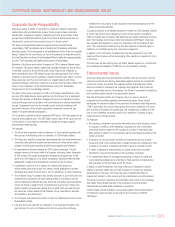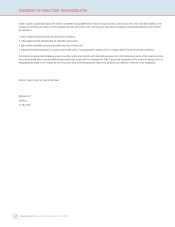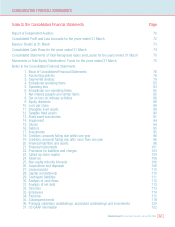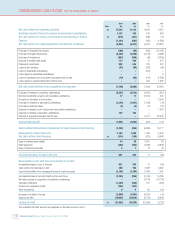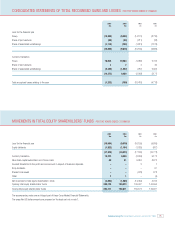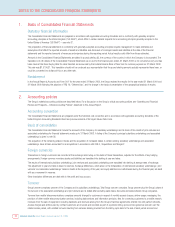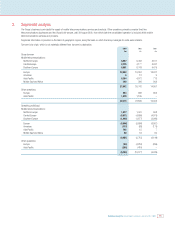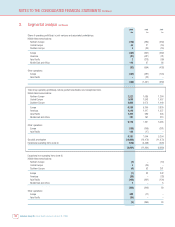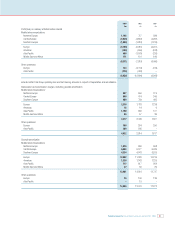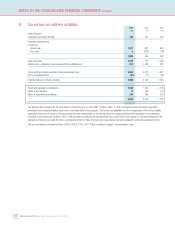Vodafone 2003 Annual Report Download - page 79
Download and view the complete annual report
Please find page 79 of the 2003 Vodafone annual report below. You can navigate through the pages in the report by either clicking on the pages listed below, or by using the keyword search tool below to find specific information within the annual report.
Vodafone Group Plc Annual Report & Accounts and Form 20-F 2003 77
unearned monthly access charges relating to periods after each accounting period deferred. Revenue from the sale of prepaid credit is deferred until such
time as the customer uses the airtime.
Other turnover from mobile telecommunications primarily comprises equipment sales, which are recognised upon delivery to customers, and connection
revenues, which are recognised upon connection of the customer to the network.
Revenue from data services and information provision is recognised when the Group has performed the related service and depending on the nature of the
service is recognised either at the gross amount billed to the customer or the amount receivable by the Group as commission for facilitating the service.
Turnover from other businesses primarily comprise amounts charged to customers of the Group’s fixed line businesses, primarily in respect of access
charges and line usage, invoiced and recorded as part of a periodic billing cycle.
Derivative financial instruments
Transactions in derivative financial instruments are undertaken for risk management purposes only.
The Group uses derivative financial instruments to hedge its exposure to interest rate and foreign currency risk. To the extent that such instruments are
matched against an underlying asset or liability, they are accounted for using hedge accounting.
Gains or losses on interest rate instruments are matched against the corresponding interest charge or interest receivable in the profit and loss account over
the life of the instrument. For foreign exchange instruments, gains or losses and premiums or discounts are matched to the underlying transactions being
hedged.
Termination payments made or received in respect of derivative financial instruments held for hedging purposes are spread over the life of the underlying
exposure where the underlying exposure continues to exist. Where the underlying exposure ceases to exist, any termination payments are taken to the profit
and loss account.
Pensions
Costs relating to defined benefit plans, which are subject to periodic valuations calculated by professionally qualified actuaries, are charged against profits,
within staff costs, so that the expected costs of providing pensions are recognised during the period in which benefit is derived from the employees’ services.
The costs of the various pension schemes may vary from the funding, dependent upon actuarial advice, with any difference between pension cost and
funding being treated as a provision or prepayment.
Defined contribution pension costs charged to the profit and loss account represent contributions payable in respect of the period.
Research and development
Expenditure on research and development is written off in the year in which it is incurred.
Goodwill
Goodwill is calculated as the surplus of fair value of consideration over fair value attributed to the identifiable net assets and liabilities (excluding goodwill) of
subsidiary, joint venture and associated undertakings acquired.
For acquisitions made after the financial year ended 31 March 1998, goodwill is capitalised and held as a foreign currency denominated asset, where
applicable. Goodwill is amortised on a straight line basis over its estimated useful economic life. For acquired network businesses, whose operations are
governed by fixed term licences, the amortisation period is determined primarily by reference to the unexpired licence period and the conditions for licence
renewal. For other acquisitions, including customer bases, the amortisation period for goodwill is typically between 5 and 10 years.
For acquisitions made before 1 April 1998, when FRS 10, “Goodwill and Intangible Assets”, was adopted, goodwill was written off directly to reserves.
Goodwill written off directly to reserves is included in the profit and loss account when the related business is sold.
Other intangible fixed assets
Purchased intangible fixed assets, including licence fees, are capitalised at cost.
Network licence costs are amortised over the periods of the licences. Amortisation is charged from commencement of service of the network. The annual
charge is calculated in proportion to the capacity of the network during the start up period and on a straight line basis thereafter.
Other intangible fixed assets are amortised over their expected useful economic life on a straight line basis.


